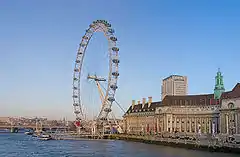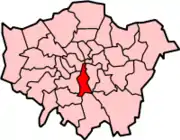| South Bank | |
|---|---|
 The London Eye on the South Bank at County Hall | |
 South Bank Location within Greater London | |
| Ceremonial county | Greater London |
| Region | |
| Country | England |
| Sovereign state | United Kingdom |
| Post town | LONDON |
| Postcode district | SE1 |
| Dialling code | 020 |
| Police | Metropolitan |
| Fire | London |
| Ambulance | London |
The South Bank is an entertainment and commercial district in central London, England on the south bank of the River Thames opposite the City of Westminster. It forms a narrow strip of riverside land within the London Borough of Lambeth (where it adjoins Albert Embankment) and the London Borough of Southwark, (where it adjoins Bankside). As such, the South Bank may be regarded as somewhat akin to the riverside part of an area known previously as Lambeth Marsh and North Lambeth.
While the South Bank is not formally defined, it is generally understood to be bounded by Westminster Bridge and Blackfriars Bridge, and to be centred approximately half a mile (800 metres) south-east of Charing Cross. The name South Bank was first widely used in 1951 during the Festival of Britain. The area's long list of attractions includes the County Hall complex, the Sea Life London Aquarium, the London Dungeon, Jubilee Gardens and the London Eye, the Southbank Centre, Royal Festival Hall, National Theatre, and BFI Southbank. In addition to their official and business functions, both the County Hall and the Shell Centre have major residential components.
As it is often waterlogged in winter, the area was slower to develop than the north bank of the Thames. Throughout its history, it has twice functioned as an entertainment district, interspersed by around a hundred years of wharfs, domestic industry and manufacturing being its dominant use.[1] Restoration began in 1917 with the construction of County Hall at Lambeth replacing the Lion Brewery. Its Coade stone symbol was retained and placed on a pedestal at Westminster Bridge and is known as the South Bank Lion.[1] The Queen's Walk pedestrianised embankment is part of the Albert Embankment, built not only for public drainage but also to raise the whole tract of land to prevent flooding.[1]
In 1951 the Festival of Britain redefined the area as a place for arts and entertainment. It now forms a significant tourist district in central London, stretching from Blackfriars Bridge in the east to Westminster Bridge in the west. Central London road, rail, and foot bridges connect the area to the north bank of the Thames—Golden Jubilee and Waterloo Bridge.[1]
History

During the Middle Ages this area developed as a place of entertainment outside the formal regulation of the City of London on the north bank; this included theatres, prostitution and bear-baiting.[1]
By the 18th century the more genteel entertainment of the pleasure gardens had developed. The shallow bank and mud flats were ideal locations for industry and docks and went on to develop as an industrial location in a patchwork of private ownership.[1]
There was a shift in use when the London County Council required a new County Hall, which was built between 1917 and 1922 on the south bank near North Lambeth's Lower Marsh.[1] The construction of County Hall returned the first section of river frontage to public use. This was extended eastwards in 1951 when a considerable area was redeveloped for the Festival of Britain.[1]
It was renamed 'South Bank' as part of promoting the Festival. The legacy of the festival was mixed, with buildings and exhibits demolished to make way for Jubilee Gardens, while the Royal Festival Hall and The Queen's Walk were retained as part of the Southbank Centre.[1] During the years following the festival the arts and entertainment complex grew with additional facilities, including the Queen Elizabeth Hall, and other arts venues opened along the river such as the Royal National Theatre.
Geography

The South Bank stretches two square miles (five square kilometres) along the southern bank of the River Thames. The western section is in the Bishops ward of the London Borough of Lambeth, and the eastern section is in the London Borough of Southwark where it joins Bankside.[2]
There is much public open space along the riverside. Between the London Studios and the Oxo Tower lies Bernie Spain Gardens, named after Bernadette Spain,[3] a local community activist who was part of the Coin Street Action Group.[4][5]
Cultural aspects
The South Bank is a significant arts and entertainment district. The Southbank Centre comprises the Royal Festival Hall, the Queen Elizabeth Hall and The Hayward Gallery. The Royal National Theatre, the London IMAX super cinema and BFI Southbank adjoin to the east, but are not strictly part of the centre.
.jpg.webp)
Polish-British visual chronicler and artist Feliks Topolski was provided a studio under one of the arches of Hungerford Bridge in 1951, where he worked consistently until his death in 1989. Topolski was commissioned to produce a 60ft by 20ft mural under the arch over Belvedere Road for the Festival of Britain, unknowingly painting only two arches up from his eventual studio.[6] Offered to him by David Eccles, it wasn't until 1953 and Queen Elizabeth II's coronation, when the windows from the dismantled annex to Westminster Abbey were repurposed to fit Topolski's studio.[6] Over the years the studio became a central feature of the South Bank, hosting countless people at his 'Open Studio' Fridays from 3pm, with an open door to whosever wished to pop their head in. Now the Studio functions as an archive and exhibition space operated by Topolski Memoir, the charity set up to preserve the artist's legacy.[7]
Topolski was provided with three further arches in 1975 by the Greater London Council (GLC), where he painted his epic 600ft long, 12-20ft high 'Memoir of the Century'. Telling his broad-ranging experience of the 20th century, Topolski painted the work from 1975 until his death, writing that he hoped to die working on it, with a brush in his hand. It remained open until 2006 in its original state, working with students, but, due to its poor condition, underwent a £3'000'000 conservation and renovation program, funded by the Heritage Lottery Fund, private donations and several other grant bodies, and raised by the artist's son, Daniel Topolski.[8][9] Reopened by the Duke of Edinburgh in 2009, the Memoir only ran for a year due to commercial pressures and was converted into the Bar Topolski, where some of Topolski's work can still be seen.[10]
County Hall was converted into The London Marriott Hotel County Hall, Sea Life London Aquarium and the London Dungeon.
The OXO Tower Wharf is towards the eastern end of South Bank, and houses Gallery@Oxo, shops and boutiques, and the OXO Tower Restaurant run by Harvey Nichols.

Gabriel's Wharf is a redeveloped wharf on the South Bank, located at 56 Upper Ground, London. It has been converted into a shopping area. Nearby places include the Oxo Tower and Bernie Spain Gardens.
The London Studios, the former home of ITV faces the Thames and Rambert Dance Company have their new studios on Upper Ground. The Old Vic and Young Vic theatres are nearby.
The Florence Nightingale Museum to nursing, medicine and the Crimean War adjoins the 'district'.
The undercroft of the Queen Elizabeth Hall has been used by skateboarders since the early 1970s. Originally an architectural dead-spot, it became a landmark of British skateboarding culture, but later was under threat, though supported by the Long Live Southbank campaign. Part of the Southbank Centre was turned into shops looking out over the river.
The South Bank was the main scene of the 1952 comedy film The Happy Family, set around the Festival of Britain.

Transport
Part of the success of the area as a visitor attraction is attributed to the high levels of public transport access. Several major railway terminals are within walking distance of the South Bank, on both sides of the river, including Waterloo, Charing Cross and Blackfriars. The London Underground has stations on or near the South Bank, from west to east, at Westminster, Waterloo, Embankment, Blackfriars and Southwark.
The development of the Thameslink Blackfriars railway station in the early 2010s, which has access from both the southern and northern side of the river, prompted the additional named signage "for Bankside and South Bank". Accessibility to the north bank is high, with connections made, from west to east, over the Westminster, Golden Jubilee, Waterloo and Blackfriars bridges. The river is utilised as a means of transport with piers along the South Bank at the London Eye, Royal Festival Hall and Bankside.

References
- 1 2 3 4 5 6 7 8 9 Farrell, Terry (2010). Shaping London. John Wiley & Sons.
- ↑ London Gazetteer of Street Names
- ↑ "Bernie Spain Gardens". coinstreet.org. Coin Street Community Builders. Retrieved 18 March 2015.
- ↑ "Gabriel's Wharf". thamespathway.com. 2008. Retrieved 21 May 2014.
- ↑ "Bernie Spain Gardens". www.london-se1.co.uk. Bankside Press. Retrieved 18 March 2015.
- ↑ Topolski, Feliks (25 January 1988). Fourteen Letters: Feliks Topolski Autobiography. London: Faber & Faber. ISBN 978-0-571-13889-0.
- ↑ "Topolski Studio". topolski.org. Retrieved 7 July 2023.
- ↑ "Topolski Century: hidden South Bank gallery reopens after £3 million makeover". London SE1. Retrieved 7 July 2023.
- ↑ "Thanks for the Memoir | Tes Magazine". www.tes.com. Retrieved 7 July 2023.
- ↑ Grove, Valerie (7 July 2023). "The Duke of Edinburgh salutes Feliks Topolski chronicle". The Times. ISSN 0140-0460. Retrieved 7 July 2023.
External links
 London/South Bank travel guide from Wikivoyage
London/South Bank travel guide from Wikivoyage- South Bank London
- Southbank Centre



